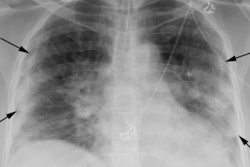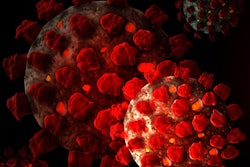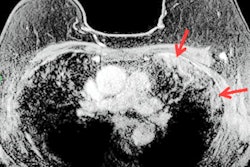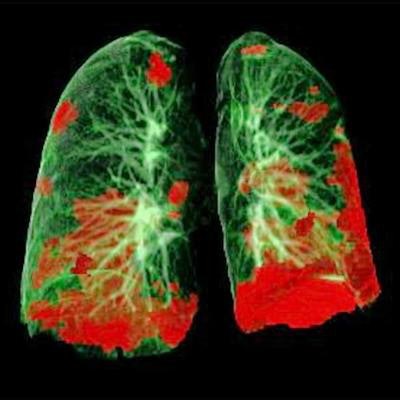
Although patients with COVID-19 may have heart and lung damage that's visible on CT scans, this can improve over a number of weeks, according to researchers from Austria. At the European Respiratory Society International Congress this week, they presented a prospective follow-up study of patients infected with the novel coronavirus.
A research team led by Dr. Sabina Sahanic revealed results from the first 86 patients enrolled in the study between 29 April and 9 June. To date, there are now over 150 patients participating, according to the team.
The researchers recruited consecutive patients with COVID-19 who were hospitalized at the University Clinic of Internal Medicine in Innsbruck, the St. Vincent Hospital in Zams, or the cardio-pulmonary rehabilitation center in Münster, Austria, and who were scheduled for evaluation six, 12, and 24 weeks after their discharge from hospital.
Patients underwent clinical examinations, laboratory tests, analysis of the amounts of oxygen and carbon dioxide in arterial blood, lung function tests, CT scans, and echocardiograms during the evaluations.
More than half of the patients at the six-week visit had at least one persistent symptom, most frequently breathlessness and coughing, and CT scans still showed lung damage in 88% of patients. By the time of their next visit 12 weeks after discharge, symptoms had improved and lung damage was reduced to 56%. The authors noted that it was still too early for results at 24 weeks post discharge.
"The good news is that the impairment tends to ameliorate over time, which suggests the lungs have a mechanism for repairing themselves," noted Sahanic, a clinical PhD student at the University Clinic in Innsbruck and part of the team which includes Associate Professor Ivan Tancevski, Professor Judith Löffler-Ragg, and Dr. Thomas Sonnweber.
The researchers revealed that 56 patients (65%) showed persistent symptoms at the time of their first visit; breathlessness (dyspnoea) was the most common (40 patients, 47%), followed by coughing (13 patients, 15%). By the 12-week visit, breathlessness had improved and was present in 31 patients (39%); however, 13 patients (15%) were still coughing
CT findings
The CT scan score indicating the severity of overall lung damage decreased from eight points at six weeks to four points at twelve weeks. Damage from inflammation and fluid in the lungs, depicted as ground-glass opacities, also improved; ground-glass sign was present in 74 patients (88%) at six weeks, but the number dropped to 48 patients (56%) at 12 weeks.
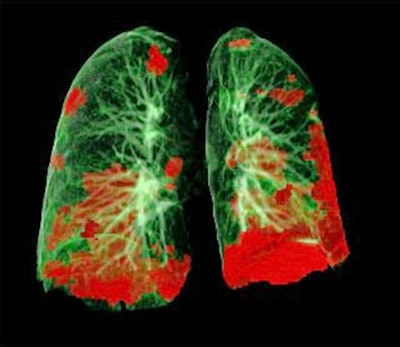 CT scan of patient's lungs showing COVID-19 damage in red. Image courtesy of Dr. Gerlig Widmann and team, department of radiology, Medical University of Innsbruck.
CT scan of patient's lungs showing COVID-19 damage in red. Image courtesy of Dr. Gerlig Widmann and team, department of radiology, Medical University of Innsbruck.Furthermore, at the six-week visit, echocardiograms showed that 48 patients (58.5%) had diastolic dysfunction of the left ventricle of the heart. In the Innsbruck cohort, the team did not observe any severe coronavirus-associated heart dysfunction in the postacute phase, and diastolic dysfunction tended to improve with time.
Lung function tests included the forced expiratory volume (FEV1) test to measure the amount of air that can be expelled forcibly in one second; the forced vital capacity (FVC) test to measure the total volume of air expelled forcibly during the FEV test; and the diffusing capacity of the lung for carbon monoxide (DLCO) test -- to assess the ability of the lungs to transfer gas from inspired air to the bloodstream.
At six weeks, 20 patients (23%) showed FEV1 as less than 80% of normal, improving to 18 patients (21%) at 12 weeks. For the FVC test, 24 patients (28%) showed FVC as less than 80% of normal, improving to 16 patients (19%) at 12 weeks. Meanwhile, 28 patients (33%) showed DLCO as less than 80% of normal, improving to 19 patients (22%) at 12 weeks.
| Improvement in COVID-19 patients between 6 and 12 weeks | ||
| At 6 weeks | At 12 weeks | |
| CT scan score of overall lung damage | 8 points | 4 points |
| Number of patients with ground-glass opacities | 74 (88%) | 48 (56%) |
| Number of patients with FEV1 test less than 80% of normal | 20 (23%) | 18 (21%) |
| Number of patients with FVC test less than 80% of normal | 24 (28%) | 16 (19%) |
| Number of patients with DLCO test less than 80% of normal | 28 (33%) | 19 (22%) |
The study findings showed the importance of implementing structured follow-up care for patients with severe COVID-19 infection, Sahanic noted.
"Importantly, CT unveiled lung damage in this patient group that was not identified by lung function tests," she said. "Knowing how patients have been affected long-term by the coronavirus might enable symptoms and lung damage to be treated much earlier and might have a significant impact on further medical recommendations and advice."




